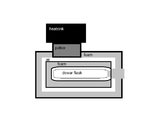neazoi
Advanced Member level 6
Hello,
I have a Dewar flask chamber and I would like to keep the temperature inside as stable as possible to 25C.
In comparison to a crystal oven heater, this means that it has to be heated (when temperature outside is <25C) and cooled (when temperature outside is >25C). a linear circuit is hetter than switched just on/off)
Is there any way I could achieve this stable temperature?
(PS. I was thinking of two peltier elements resting outside the dewar flask.
The cold surface of one of them would be connected with an aluminum bar to the inside of the dewar flask.
The hot surface of the other would be connected with an aluminum bar to the inside of the dewar flask.
And then some kind of controller, to control both.)
Another way I was thinking of, was to use a peltier cooler and cool the exterior of the dewar flasks, just like I was operating the chamber on a cool day. Then use an ordinary crystal oven inside, but set for only 25C. (attached image)
Any other ideas?
I have a Dewar flask chamber and I would like to keep the temperature inside as stable as possible to 25C.
In comparison to a crystal oven heater, this means that it has to be heated (when temperature outside is <25C) and cooled (when temperature outside is >25C). a linear circuit is hetter than switched just on/off)
Is there any way I could achieve this stable temperature?
(PS. I was thinking of two peltier elements resting outside the dewar flask.
The cold surface of one of them would be connected with an aluminum bar to the inside of the dewar flask.
The hot surface of the other would be connected with an aluminum bar to the inside of the dewar flask.
And then some kind of controller, to control both.)
Another way I was thinking of, was to use a peltier cooler and cool the exterior of the dewar flasks, just like I was operating the chamber on a cool day. Then use an ordinary crystal oven inside, but set for only 25C. (attached image)
Any other ideas?
Attachments
Last edited:
